
Photographs from the anatomical collection of
The Mütter Museum of the
College of Physicians of Philadelphia
1997 through 2010
No. 2202.1: Two hands with gout
The Mütter Museum is named for Dr. Thomas Dent Mütter (1811-1859), who in 1856 offered his collection of medical specimens and models to the College of Physicians of Philadelphia (CPP). Mütter described the College as the “body best qualified by the character of its members and the nature of its pursuits for undertaking the trust.”¹ The institution was founded in 1787 by two dozen eminent Philadelphia physicians — among the foremost being Benjamin Rush, a signer of the Declaration of Independence. The express purpose of this body was “to advance the Science of Medicine and to thereby lessen human misery…” and to encourage “order and uniformity in the practice of Physick.”²
Thomas Dent Mütter was born 9 March 1811 in Richmond, Virginia. Mütter attended Virginia's Hampden-Sidney College before entering the University of Pennsylvania's School of Medicine, from which he graduated in 1831. He was known around Philadelphia as a flamboyant character, prone to driving about town in an audacious carriage and attended by a servant in full livery attire. Mütter was described thusly by one of his contemporaries:
“In his dress he was the pink of neatness; and there was that dash, enthusiasm, earnestness, and action about him which never fail to elicit attention and create popularity… [Mütter] was all things to all men, not unfrequently at the expense of other persons' comfort and convenience.”³
Along with the ego, Dr. Mütter earned a reputation as a gifted surgeon and lecturer. His skills in both pursuits were held in such high regard that he was offered the chair of Surgery at Jefferson Medical College in 1841. Mütter held that position until 1856, when he retired due to poor health — perhaps a worsening of the gout that had allegedly plagued him for many years.
It was on May 20th of that year that Dr. Mütter offered to bequeath his collection to the College of Physicians. The offer included a $30,000 endowment to pay the salaries of a curator and lecturer, and fund the care and future expansion of the collection. Before the CPP could take ownership of the collection, Mütter stipulated that they must construct a fire-proof building to house it. This appealed to the College, which had been renting its lodgings and desired a suitable location for its meetings and to house their growing library. An agreement was signed in 1859 — two months before Dr. Mütter died — and the collection placed in its new home in 1863.
The 1,344 items from Dr. Mütter — wet and dry preparations, wax models, plaster casts, and illustrations — were added to the 92 pathological specimens collected between 1849 and 1852 by Dr. Isaac Parish. Over the years, the Mütter Museum continued to grow through purchases and donations. In 1871, the Museum began collecting out-dated medical equipment, including Benjamin Rush's medicine chest and the sewing kit of Florence Nightingale. Three years later the Mütter Museum had a banner year: in 1874 they acquired not only the conjoined livers and plaster death cast of Chang & Eng Bunker, the original Siamese Twins, following their autopsy at CPP; but also finalized the purchase of 100 human skulls from Austrian anatomist and phrenology debunker Joseph Hyrtl; and received the early 19th-century corpse of the Soap Lady, whose fatty tissues decomposed into stable — but latherable — adipocere. Another major acquisition occurred in 1877, with the purchase of the 7-foot 6-inch skeleton of a Kentucky giant.*
Such impressive growth in the collections required larger quarters. In 1908, the College of Physicians of Philadelphia began construction of the handsome building it now occupies on 22nd Street. Today, the collection contains more than 20,000 objects. The Mütter Museum celebrated its 150th anniversary in 2009.
¹ “Records of the Mütter Museum III”, cpparchives.org/repositories/2/resources/2022 (retrieved 1-Jan-2025)² “Detailed History of the College of Physicians of Philadelphia”, web.archive.org/web/20101121040938/http://collphyphil.org/Site/detailedhistory.html (retrieved 21-Nov-2010)³ Samuel D. Gross, Autobiography of Samuel D. Gross, M.D., volume 2, Philadelphia: W. B. Saunders, 1898 * Gretchen Worden, “Pathological Treasures of the Mütter Museum”, Mütter Museum of the College of Physicians of Philadelphia, New York: Blast Books, 2002—————
I was first permitted by Mütter Museum director Gretchen Worden to take some 35mm film reference photographs of the collection back in 1997. While that was a great honor, I was initially disappointed in how those turned out as they seemed over exposed. Ten years later, I came upon the negatives where they had been forgotten in a drawer and I realized that the negatives themselves were fine and my previous impression was due to a mediocre printing job. After digitally scanning and processing the negatives myself, the results inspired me to pursue the project now called Cabinet of Curiosities. In August 2008, I had the opportunity to return to the Mütter Museum with cameras and sketchbook in hand, and returned many times afterward.
These photographs are dedicated to the memory of Gretchen Worden (1947-2004), who provided the access that made them possible.

Chang & Eng No. 1 - Plaster death cast of Chang & Eng Bunker (1811-1874), the original Siamese Twins. During their long career the twins amassed and lost several fortunes. In the 1840s, Chang and Eng became naturalized American citizens and retired from show business to live quiet lives as Southern planters. In 1843, they each married — sisters Adelaide and Sarah Yates — and began to father numerous children, twenty-one between them. In the wake of the Civil War, the twins were forced to return to show business to recoup their financial losses. When Chang and Eng died during the night of 16-17 January 1874 (Chang first of an apparent stroke, then Eng several hours later due to exsanguination), Drs. William Pancoast and Harrison Allen from the College of Physicians traveled to Mount Airy, North Carolina, to collect the bodies for transportation back to Philadelphia for autopsy. As the twins had died some weeks before the doctors arrived, it was necessary to disinter the remains and quickly embalm them. The bodies were then soldered into a tin box for transportation back to the College, where a more thorough embalming procedure was undertaken prior to the autopsy on Monday, 9 February 1874. During the autopsy it was discovered that the twins shared a conjoined liver, which is now displayed in a large jar beneath their death cast.

Chang & Eng No. 2

Hyrtl Skull Collection No. 1 - Austrian anatomist Joseph Hyrtl (1810-1894) amassed a large collection of human skulls and other bones from around the world for use in comparative anatomy studies. The Mütter Museum acquired more than 100 skulls from his collection in 1874.

No. 15-2-11: Hypertrophied rats

No. F1993.28A
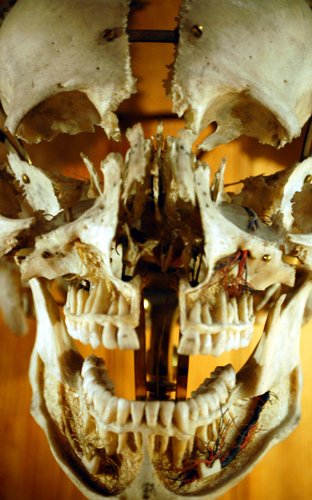
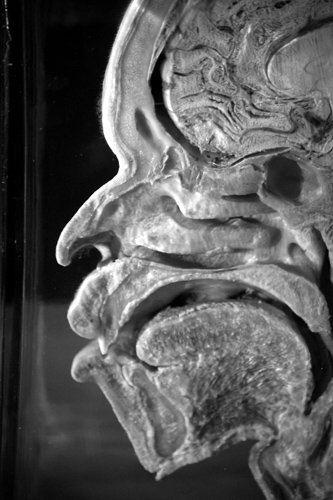
Section


Amended (Hyrtl Skull Collection)



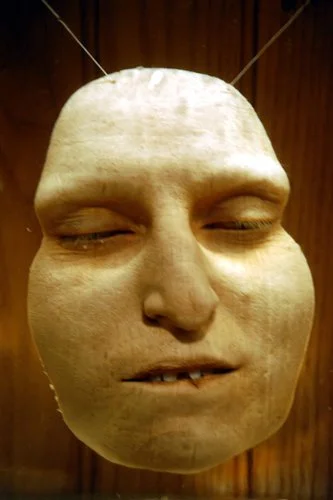
Suspended profile

Brains of epileptics


Hyrtl Skull Collection No. 3



Tuberculosis (Hyrtl Skull Collection)


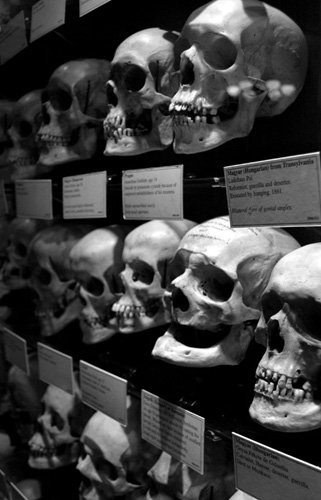

Tsantsa - A shrunken head prepared by the Jivaro (Shuar) people of South America


Deciduous - Prepared skull showing descent of permanent teeth

Pugilist



Genovese

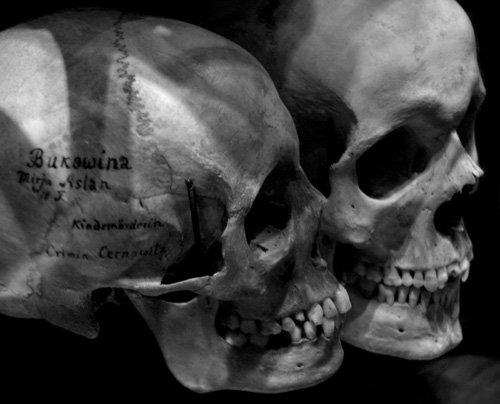
Child murderer's skull

Slice

Calcified No. 1

Calcified No. 2 - Skeleton of Harry Eastlack (1933-1973) who suffered from fibrodysplasia ossificans progressiva, a condition in which muscle and connective tissue turns to bone.

Dwarf skeleton - Skeleton of Mary Ashberry, 3’ 6” tall, who died in 1856. While living and working in Norfolk, Virginia, Ms. Ashberry became pregnant. Tragically, Mary's pelvis was too contracted to allow the natural birth of her child and they both died in the attempt.

Rumanian, from Moldavia (Hyrtl Skull Collection)

Categorized skulls (Hyrtl Skull Collection) - Austrian anatomist and phrenologist Joseph Hyrtl (1810-1894) amassed a large collection of human skulls and other bones from around the world for use in comparative anatomy studies. The Mütter Museum acquired more than 100 skulls from his collection in 1874.

Conjoined - Plaster death cast of conjoined twins Mina and Minnie Finley (b. 12 October 1870, d. 18 July 1871) of Peru Township, Ohio.

McClellan skeleton


Neo-classical tumor - A 19th-century French sculpture altered to display a large tumor of the parotid (salivary) gland

Hyrtl Skull Collection No. 2



Chang & Eng No. 3



Haunted - double-exposure

No. 1145.70 (Hydrocephalus)

Dermoid cyst - An ovarian cyst containing teeth and hair

Lymphatic system - anatomical wax
